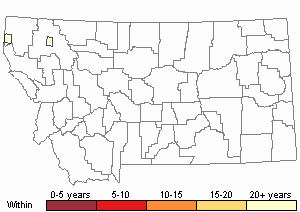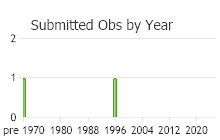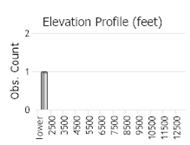View in other NatureServe Network Field Guides
NatureServe
Montana
Utah
Wyoming
Idaho
Wisconsin
British Columbia
South Carolina
Yukon
California
New York
Broodbranch Fork Moss - Dicranum flagellare
Other Names:
Whip Fork Moss
General Description
Plants: Acrocarpous. Growing in crowded clumps of erect shoots (FNA 2007), deep green or green with yellow tones (Lawton 1971), typically with some plants of the clump producing several small, deep green, flagelliform branches in a cluster; flagelliform branches occurring near the top of the stem and arising from stem-leaf junctures, 1-4 mm in length, and round in X-section. Stems 5-60 mm tall, thickly covered in pale brown to russet-colored woolly mats of rhizoids (FNA 2007).
Leaves: Flagelliform branch leaves short and pressed tightly to the stem, presenting a catkin-like appearance, short and egg- to tongue-shaped with leaf tip obtuse or nearly so, the costa lacking or short and faint. Stem leaves curled and twisted when dry, straight or curved and pointed more-or-less toward one side of the stem, 1-5 mm in length, 0.3-0.6 mm in width, cupped below, lance-shaped to somewhat egg-shaped below, narrowing to form a tube-like subula; margins finely saw-toothed to smooth distally; leaf tip narrowly angled; costa reaching or nearly reaching the apex, sometimes finely roughened dorsally with minute teeth or papillae, and dorsal crests near the leaf tip lacking (FNA 2007).
Leaf Cells: Lamina of 1 layer of cells, the cells smoothly arranged or slightly roughened from overlapping cell ends, the walls lacking bulges between cells; upper laminal cells square or short and quadrangular (FNA 2007); basal cells quadrangular or very narrowly so (Lawton 1971); alar cells distinct, inflated (FNA 2007), typically somewhat brown (Crum & Anderson et al. 1981), not reaching the nerve, 1 cell-layer thick; costa in X-section with ventral and dorsal stereid bands above and below but not at mid-leaf, guide cells in 1 row, the cells of the ventral epidermal layer not distinct, and a few cells of the dorsal epidermal layer standing out (FNA 2007).
Phenology
Capsules ripen in spring (FNA 2007).
Diagnostic Characteristics
The flagelliform branches are usually numerous and seldom absent. The more stunted the growth of the plant, the more flagelliform branches it produces (Crum & Anderson et al. 1981).
In the absence of flagelliform branches, D. flagellare may be confused for D. montanum (FNA 2007). D. montanum has leaf cells from mid-leaf to near the leaf tip that are quite papillose. Those of D. flagellare are smooth or only faintly papillose close to the apex (Lawton 1971).
Range Comments
North American Range
Canada: NT and the southern tier; USA: MT, AZ, CO, SD, NE, OK, and states in the eastern half of the country; Mexico (FNA 2007). Known in Montana from Flathead and Lincoln Counties (Elliott 2016).
Observations in Montana Natural Heritage Program Database
Number of Observations: 5
(Click on the following maps and charts to see full sized version)
Map Help and Descriptions
Relative Density

Recency



 (Observations spanning multiple months or years are excluded from time charts)
(Observations spanning multiple months or years are excluded from time charts)
Habitat
Frequently on decaying wood and stumps, less often on humus overlying stones (Crum & Anderson et al. 1981), hillocks in swamps (Lawton 1971), bogs. Elevation: 0-4270 feet (FNA 2007).
Reproductive Characteristics
Dioicous. Inner perichaetial bracts enveloping the stem, narrowing suddenly above to a long acumen. Seta single, 10-25 mm tall. Capsule nearly vertical, straight, lined when dry, ochre; theca 2-2.5 mm in length (Lawton 1971); peristome of 16 teeth, each separated ca halfway down into 2 lobes (seldom 3), russet, with papillae above. Calyptra hood-like, hairless, sheltering much of the capsule, falling away easily (FNA 2007).
Specialized vegetative reproduction by means of the fugacious (easily falling away), flagelliform branches (FNA 2007).
Stewardship Responsibility
References
- Literature Cited AboveLegend:
 View Online Publication
View Online Publication Crum, H.A. and L.E. Anderson. 1981. Mosses of Eastern North America. 2 volumes. Columbia University Press, New York. 1328 pp.
Crum, H.A. and L.E. Anderson. 1981. Mosses of Eastern North America. 2 volumes. Columbia University Press, New York. 1328 pp. Elliott, J.C. and A.K. Pipp. 2018. A Checklist of Montana Mosses (1880-2018). Updated 3 January, 2020. Montana Natural Heritage Program, Helena, Montana. 73 pp.
Elliott, J.C. and A.K. Pipp. 2018. A Checklist of Montana Mosses (1880-2018). Updated 3 January, 2020. Montana Natural Heritage Program, Helena, Montana. 73 pp. Flora of North America Editorial Committee, eds. 2007. Flora of North America North of Mexico. Volume 27. Bryophytes: Mosses, Part 1. Oxford University Press, Inc., NY. xxi + 713 pp.
Flora of North America Editorial Committee, eds. 2007. Flora of North America North of Mexico. Volume 27. Bryophytes: Mosses, Part 1. Oxford University Press, Inc., NY. xxi + 713 pp. Lawton, E. 1971. Moss Flora of the Pacific Northwest. Hattori Botanical Laboratory. Japan: Yamabuki-cho, Shinjuku-ku, Tokyo. 362 pages plus appendices.
Lawton, E. 1971. Moss Flora of the Pacific Northwest. Hattori Botanical Laboratory. Japan: Yamabuki-cho, Shinjuku-ku, Tokyo. 362 pages plus appendices. Smith, A.J.E. 1980. The Moss Flora of Britain and Ireland. Cambridge University Press, Cambridge. 705 pp.
Smith, A.J.E. 1980. The Moss Flora of Britain and Ireland. Cambridge University Press, Cambridge. 705 pp.
- Additional ReferencesLegend:
 View Online Publication
View Online Publication
Do you know of a citation we're missing? Elliot, J. C. 1993. Second checklist of Montana mosses. Unpublished report. U.S. Forest Service, Region 1. Missoula, MT. 45 pp.
Elliot, J. C. 1993. Second checklist of Montana mosses. Unpublished report. U.S. Forest Service, Region 1. Missoula, MT. 45 pp. Lawton, E. 1971. Keys for the Identification of the Mosses on the Pacific Northwest. Reprinted from 'Moss Flora of the Pacific Northwest'. Published as Supplement No. 2 of the Journal of the Hattori Botanical Laboratory. Nichinan, Miyazaki, Japan. 66 pp.
Lawton, E. 1971. Keys for the Identification of the Mosses on the Pacific Northwest. Reprinted from 'Moss Flora of the Pacific Northwest'. Published as Supplement No. 2 of the Journal of the Hattori Botanical Laboratory. Nichinan, Miyazaki, Japan. 66 pp. Vitt, D. J. Marsh, and R. Bovey. 1988. Mosses, Lichens & Ferns of Northwest North America. Seattle, WA: University of Washington Press. 296 p.
Vitt, D. J. Marsh, and R. Bovey. 1988. Mosses, Lichens & Ferns of Northwest North America. Seattle, WA: University of Washington Press. 296 p.
- Web Search Engines for Articles on "Broodbranch Fork Moss"





